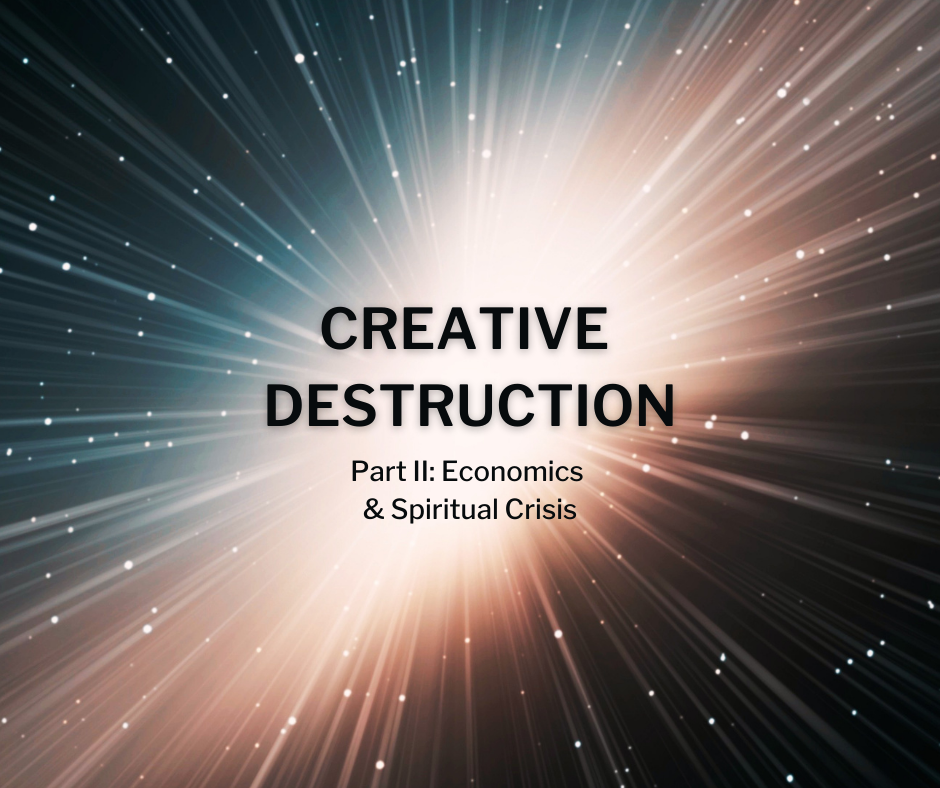(In case you missed it, here’s a link to Creative Destruction: Part I)
I’m writing today under the influence of the full moon, and holding in mind the conditioning keynote of Libra: I choose the way which leads between the two great lines of force. It’s a perfect keynote as we consider the next installment of Creative Destruction. Let’s think of creation and destruction as two great lines of force, connected by the choices we make, and how we harness the energies of our lives. Let’s see how that current of thought flows through this essay.
According to the Ageless Wisdom tradition, spiritual tension leads to crisis. Crisis either destroys a system, or launches it into a more inclusive, expansive, creative way of being.
But maybe it’s not either; maybe it’s both.
The two poles of creation and destruction are linked through consciousness, and according to the sources I’ve searched, humanity is (or can be) the link. What does that have to do with economics?
Economics is a lens social scientists use to study “how individuals, governments, firms and nations make choices on allocating scarce resources to satisfy their unlimited wants” (Investopedia.com). Economics rests on the assumptions of “scarce resources” and “unlimited wants.” This mentality of there’s not enough and I want it all has historically driven policy-makers—historically white men—to construct economic systems based on fear and greed: a lethal combination. While it can generate competitive markets that drive innovation and improve our lives, if left unchecked, it can also engorge the worst of our nature.
This entire economic paradigm is at a point of tension leading to crisis. This will either destroy the system, or launch it into a more inclusive, expansive, creative way of being. Or both. The cracks in the system let light in and there are signs of greater inclusivity and creativity: instead of exploiting scarce resources, we’re constructing with sustainability in mind; instead of unlimited wants, we’re discerning true needs; instead of exclusively white men, the US Congress is more racially and ethnically diverse than at any previous point in history. The cracks let light in: cue Creative Destruction on stage.
The Austrian economist, Joseph Shumpeter, is credited with coining the term Creative Destruction around 1942. He defined this principle as innovation that “incessantly revolutionizes the economic structure from within, incessantly destroying the old one, incessantly creating the new one.” There are countless examples of this principle: anytime a new technology replaces a previous one; when the phonograph replaced the piano; when the computer replaced the typewriter; when the car replaced the horse and buggy.
With each wave of innovation, Creative Destruction alters the forms it touches. Life moves in new ways. Some economists argue that innovation is moving too fast now. They say the destructive principle is outstripping our creative capacity to keep pace. Maybe that’s true. Sometimes I feel that way (like today). I feel overwhelmed by destructive force. I’ve recently withstood impacts in my own life that have thrown me off course. I’m in some unmarked terrain and I’ve lost which way is up. But that’s why I write; not because I understand, but because I need to. I grab a lifeline of thought and pull my way through my own crisis towards a more inclusive, expansive, creative way of being. I remember my favorite esoteric dictum: an esotericist knows because she works, and never the other way around. So pulling back to economics…
Economic markets are responsive systems. They react to what we put in and take out of them. They are sensitive: constantly adjusting and transforming just like every other living organism. If we recognize this inherent livingness, and see the system itself as evolving like the rest of us, how might that change our understanding and stewardship of it? If humanity is the linking consciousness between creation and destruction, how do we harness that great responsibility?
Creative Destruction is full of insights and it didn’t begin with economics: the idea seems as old as time itself. We’ll open that door in our next installment, where we’ll sit at the feet of Goddesses and archetypes, mythic creatures and ferocious beasts, all with much to teach us about how to harness the winds of creative energies for good. I hope you’ll ride along.
